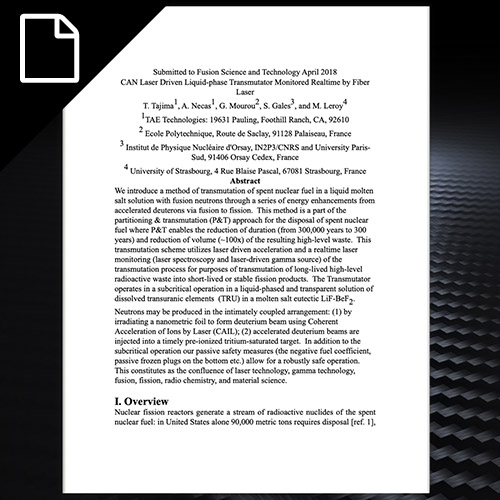
Jun 2019 | Research Library, Papers, Fusion Energy, Fusion Research, Fusion Science, Fusion Technology, Modeling, Plasma Research, Theory
June 2019 | S.V. Putvinski | Nuclear Fusion | Paper
Fusion reactivity for the pB11 fuel has been reassessed for magnetic confinement devices. This study is based on two factors: new measurements of the fusion reaction cross-sections and an accounting of the kinetic effects that lead to the increase of the number of protons at higher energies (with respect to a pure Maxwellian).

Apr 2019 | Research Library, Posters, Confinement, Equilibrium, Fast Particles, Fusion Energy, Fusion Research, Fusion Science, Fusion Technology, Instabilities, Modeling, Overview, Plasma Research, Simulation, Stability, Theory, Transport, Turbulence
April 2019 | A.Necas | 2019 Sherwood Fusion Theory | Poster
TAE Technologies, Inc, has an active fusion plasma research program centered around the FRC (Field Reversed Configuration) magnetic topology and the existing C-2W (aka Norman) experiment.

Apr 2019 | Research Library, Papers, Fueling, Fusion Energy, Fusion Research, Fusion Science, Fusion Technology, Modeling, Plasma Research, Simulation
April 12, 2019 | T. Tajima | Paper
We introduce a method of transmutation of spent radioactive nuclei in a liquid molten salt solution with fusion neutrons through a series of energy enhancements from accelerated deuterons via fusion to fission. This method is a part of the partitioning & transmutation (P&T) approach for the disposal of spent nuclear fuel where P&T enables the reduction of duration and volume of the spent nuclear fuel storage.

Nov 2018 | Research Library, Posters, Equilibrium, Fusion Energy, Fusion Research, Fusion Science, Fusion Technology, Modeling, Plasma Profiles, Plasma Research, Theory
October 2018 | L. Steinhauer | APS-DPP | Poster
The magnetic structure of FRCs cannot be measured directly by existing diagnostics. A new tool “Grushenka” finds the structure based on magnetic measurements at the vessel wall.
Nov 2018 | Research Library, Posters, Fusion Energy, Fusion Research, Fusion Science, Fusion Technology, Modeling, Plasma Research, Simulation, Theory
October 2018 | A. Necas | APS-DPP | Poster
Spent nuclear fuel from current nuclear reactors generally managed by two distinct policies: once-through (U.S., Sw) and U/Pu recycling (Fr,J)

Oct 2018 | Research Library, Papers, Diagnostics, Fusion Energy, Fusion Research, Fusion Science, Fusion Technology, Instabilities, Modeling, Plasma Research, Theory, Top Level
October 2018 | B. Deng | Nuclear Fusion | Paper
In modern F experiments at TAE Technologies, classical FRC instabilities are suppressed
by advanced neutral beam injection and edge biasing methods, leading to high plasma confinement and fast ion pressure built-up which is comparable to the bulk plasma pressure.



